Roots blowers are mostly three blade type on the market at present, and two sets of three blade impellers complete three times of suction and exhaust for each revolution of the three blade roots blower. It belongs to positive displacement fan and is a fixed volume rotary pneumatic machinery. The cylinder is contained by the casing and the wall plates at both ends. A pair of mutually "occluding" impellers (because of the gap, the two impellers do not contact directly) separate the air inlet from the exhaust port. Through the rotation of a pair of synchronous gears, the two impellers rotate in the cylinder at the same speed direction. During the rotation, the gas at the air inlet is constantly pushed to the exhaust port by the impeller, So as to achieve the purpose of forced exhaust. Simple structure and stable performance.
Roots blower is a volume rotary blower. Its big feature is that when the pressure is adjusted within the allowable range, the flow changes little, the pressure selection range is wide, and it has the characteristics of forced gas transmission. The medium does not contain oil during transportation. Simple structure, convenient maintenance, long service life and low vibration of the whole machine.
Roots blower is a volume rotary blower?, A rotary compressor that compresses and transports gas by using two blade rotors to make relative motion in the cylinder. The compressor keeps the two rotors engaged by the synchronous gear at the rotor shaft end. Each concave curved surface on the rotor forms a working volume with the inner wall of the cylinder. During the rotation of the rotor, the gas is taken away from the suction port. When the rotor moves to the exhaust port near which it is connected with the exhaust port, the pressure in the working volume suddenly rises due to the backflow of high pressure gas, and then the gas is transported to the exhaust channel. The two rotors work alternately. The two rotors do not contact each other, and they are sealed by a tightly controlled gap, so the discharged gas is not polluted by lubricating oil.
Roots blower is simple in structure and easy to manufacture. It is suitable for gas transmission and pressurization at low pressure occasions, and can also be used as a vacuum pump. The periodic suction, exhaust and instantaneous constant volume compression cause the pulsation of gas flow velocity and pressure, which will produce large aerodynamic noise. In addition, the clearance between rotors and between rotors and cylinders will cause gas leakage, thus reducing efficiency. The Roots blower has a displacement of 0.15~150 m (/min) and a rotating speed of 150~3000 rpm. The single stage pressure ratio is usually less than 1.7, up to 2.1, and can be used in series with multiple stages.
Roots blower transports clean air, clean kerosene, sulfur dioxide and other inert gases. In view of the above characteristics, it can be widely used in metallurgy, chemical industry, fertilizer, petrochemical, instrument and building materials industries. Operation regulation and energy saving of fan According to the theory of fluid mechanics, the flow process of gas will be accompanied by loss. For example, after the gas flows through the throttling device, the pressure of the gas flow will be reduced accordingly, that is, they will lose the useful work of the fan. Because all this happens in the process of the fan conveying gas, it wastes the energy of the fan.
Roots blower is inside the casing, and there is always a small gap between the two opposite rotating impellers and the inner wall of the casing and between the impellers. As a certain amount of gas surrounded by the inner wall of the housing when an impeller passes through the suction inlet, it is transmitted from the suction side to the high-pressure side, and operates continuously in such a cycle. At the moment when the top of the impeller reaches the exhaust outlet, the high-pressure gas on the exhaust side is compressed due to counter flow in the casing. Since there is always a small gap between the impeller and each impeller on the inner wall of the fan housing, part of the gas at the outlet of the fan returns through the gap, and these return gases produce pulsations with sudden pressure changes.
1. In the case of Roots blower, there is always a small gap between two impellers rotating at a constant speed in opposite directions, the inner wall of the case and each impeller.
2. As a certain amount of gas surrounded by the inner wall of the housing when an impeller passes through the suction inlet, it is transmitted from the suction side to the high-pressure side, so it circulates and operates continuously.
3. At the moment when the top of the impeller reaches the exhaust outlet, the high-pressure gas on the exhaust side is compressed due to counter flow in the casing.
4. Since there is always a small gap between the impeller and each impeller on the inner wall of the fan housing, part of the gas at the outlet of the fan returns through the gap, and these return gases produce pulsation with the sudden pressure change.
I believe that after reading the above content, you should also understand why Roots blower has pulsation, and I hope it will help you.
Text term label: Roots blower
Link to this article: //wuhanzhcs.com/html/news/n02/671.htm










